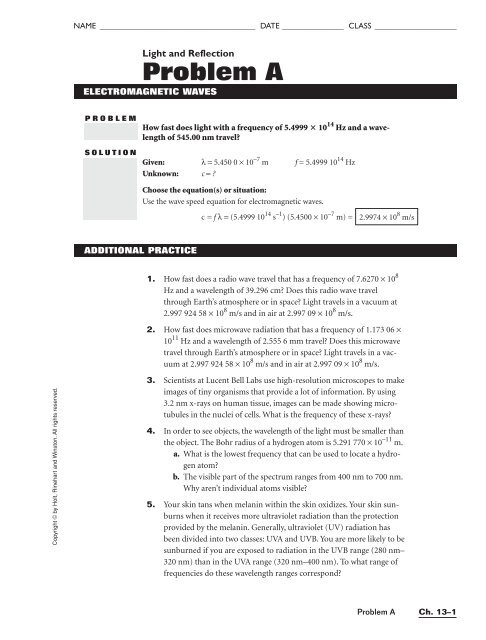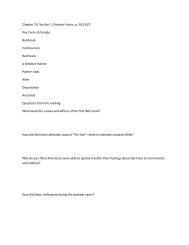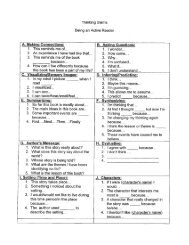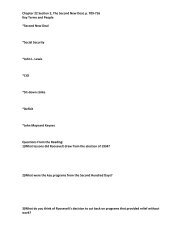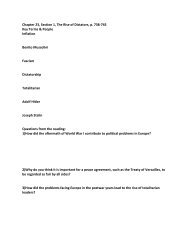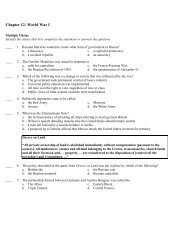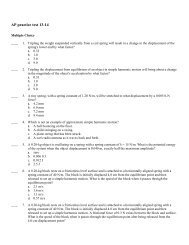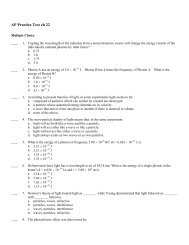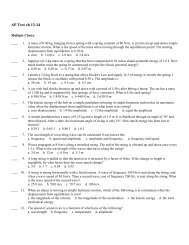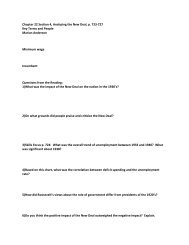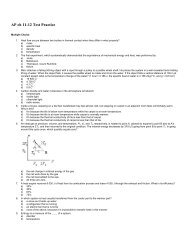Problem A
Problem A
Problem A
You also want an ePaper? Increase the reach of your titles
YUMPU automatically turns print PDFs into web optimized ePapers that Google loves.
NAME ______________________________________ DATE _______________ CLASS ____________________<br />
Light and Reflection<br />
<strong>Problem</strong> A<br />
ELECTROMAGNETIC WAVES<br />
PROBLEM<br />
SOLUTION<br />
How fast does light with a frequency of 5.4999 10 14 Hz and a wavelength<br />
of 545.00 nm travel?<br />
Given: λ=5.450 0 × 10 –7 m f = 5.4999 10 14 Hz<br />
Unknown: c = ?<br />
Choose the equation(s) or situation:<br />
Use the wave speed equation for electromagnetic waves.<br />
c = f λ=(5.4999 10 14 s –1 ) (5.4500 × 10 –7 m) = 2.9974 × 10 8 m/s<br />
ADDITIONAL PRACTICE<br />
1. How fast does a radio wave travel that has a frequency of 7.6270 × 10 8<br />
Hz and a wavelength of 39.296 cm? Does this radio wave travel<br />
through Earth’s atmosphere or in space? Light travels in a vacuum at<br />
2.997 924 58 × 10 8 m/s and in air at 2.997 09 × 10 8 m/s.<br />
2. How fast does microwave radiation that has a frequency of 1.173 06 ×<br />
10 11 Hz and a wavelength of 2.555 6 mm travel? Does this microwave<br />
travel through Earth’s atmosphere or in space? Light travels in a vacuum<br />
at 2.997 924 58 × 10 8 m/s and in air at 2.997 09 × 10 8 m/s.<br />
Copyright © by Holt, Rinehart and Winston. All rights reserved.<br />
3. Scientists at Lucent Bell Labs use high-resolution microscopes to make<br />
images of tiny organisms that provide a lot of information. By using<br />
3.2 nm x-rays on human tissue, images can be made showing microtubules<br />
in the nuclei of cells. What is the frequency of these x-rays?<br />
4. In order to see objects, the wavelength of the light must be smaller than<br />
the object. The Bohr radius of a hydrogen atom is 5.291 770 × 10 –11 m.<br />
a. What is the lowest frequency that can be used to locate a hydrogen<br />
atom?<br />
b. The visible part of the spectrum ranges from 400 nm to 700 nm.<br />
Why aren’t individual atoms visible?<br />
5. Your skin tans when melanin within the skin oxidizes. Your skin sunburns<br />
when it receives more ultraviolet radiation than the protection<br />
provided by the melanin. Generally, ultraviolet (UV) radiation has<br />
been divided into two classes: UVA and UVB. You are more likely to be<br />
sunburned if you are exposed to radiation in the UVB range (280 nm–<br />
320 nm) than in the UVA range (320 nm–400 nm). To what range of<br />
frequencies do these wavelength ranges correspond?<br />
<strong>Problem</strong> A Ch. 13–1
NAME ______________________________________ DATE _______________ CLASS ____________________<br />
6. Suppose you must decide whether a pre-Columbian mask is genuine<br />
before buying it for a museum. It looks genuine, but to ensure its authenticity,<br />
you shine X rays of wavelength 1.67 × 10 –10 m on it to see if<br />
a certain element is present. What is the frequency of this radiation?<br />
7. Suppose you use ultraviolet light of frequency 9.5 × 10 14 Hz to determine<br />
whether a mineral is fluorescent. To what wavelength does this<br />
correspond?<br />
8. Meteorologists use Doppler radar to watch the movement of storms.<br />
If a weather station uses electromagnetic waves with a frequency of<br />
2.85 × 10 9 Hz, what is the length of the wave?<br />
9. PCS cellular phones have antennas that use radio frequencies from<br />
1800–2000 MHz. What range of wavelengths corresponds to these<br />
frequencies?<br />
10. Suppose the microwaves in your microwave oven have a frequency of<br />
2.5 × 10 10 Hz.<br />
a. What is the wavelength of these microwaves?<br />
b. The holes in the door of a microwave oven have a radius of<br />
1.2 mm. Why don’t microwaves pass through these holes?<br />
c. Visible light has a wavelength that ranges from 400 nm to<br />
700 nm. Would visible light be able to pass through the holes?<br />
Why or why not?<br />
Copyright © by Holt, Rinehart and Winston. All rights reserved.<br />
Ch. 13–2<br />
Holt Physics <strong>Problem</strong> Bank


